This article originally appeared in The Conversation.
Featured image: Tropical rainforest.
By Bonnie Waring, Imperial College London
One morning in 2009, I sat on a creaky bus winding its way up a mountainside in central Costa Rica, light-headed from diesel fumes as I clutched my many suitcases. They contained thousands of test tubes and sample vials, a toothbrush, a waterproof notebook and two changes of clothes.
I was on my way to La Selva Biological Station, where I was to spend several months studying the wet, lowland rainforest’s response to increasingly common droughts. On either side of the narrow highway, trees bled into the mist like watercolours into paper, giving the impression of an infinite primeval forest bathed in cloud.
As I gazed out of the window at the imposing scenery, I wondered how I could ever hope to understand a landscape so complex. I knew that thousands of researchers across the world were grappling with the same questions, trying to understand the fate of tropical forests in a rapidly changing world.
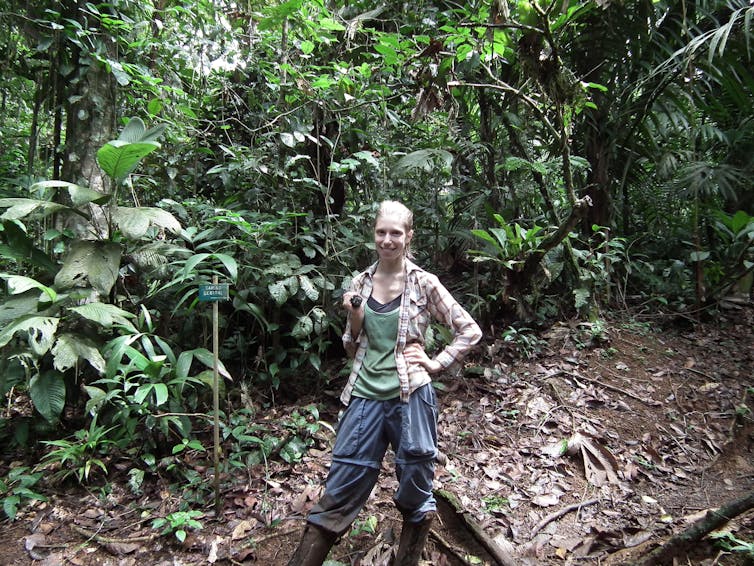
Author provided
Our society asks so much of these fragile ecosystems, which control freshwater availability for millions of people and are home to two thirds of the planet’s terrestrial biodiversity. And increasingly, we have placed a new demand on these forests – to save us from human-caused climate change.
Plants absorb CO₂ from the atmosphere, transforming it into leaves, wood and roots. This everyday miracle has spurred hopes that plants – particularly fast growing tropical trees – can act as a natural brake on climate change, capturing much of the CO₂ emitted by fossil fuel burning. Across the world, governments, companies and conservation charities have pledged to conserve or plant massive numbers of trees.
But the fact is that there aren’t enough trees to offset society’s carbon emissions – and there never will be. I recently conducted a review of the available scientific literature to assess how much carbon forests could feasibly absorb. If we absolutely maximised the amount of vegetation all land on Earth could hold, we’d sequester enough carbon to offset about ten years of greenhouse gas emissions at current rates. After that, there could be no further increase in carbon capture.
Yet the fate of our species is inextricably linked to the survival of forests and the biodiversity they contain. By rushing to plant millions of trees for carbon capture, could we be inadvertently damaging the very forest properties that make them so vital to our wellbeing? To answer this question, we need to consider not only how plants absorb CO₂, but also how they provide the sturdy green foundations for ecosystems on land.
How plants fight climate change
Plants convert CO₂ gas into simple sugars in a process known as photosynthesis. These sugars are then used to build the plants’ living bodies. If the captured carbon ends up in wood, it can be locked away from the atmosphere for many decades. As plants die, their tissues undergo decay and are incorporated into the soil.
While this process naturally releases CO₂ through the respiration (or breathing) of microbes that break down dead organisms, some fraction of plant carbon can remain underground for decades or even centuries. Together, land plants and soils hold about 2,500 gigatonnes of carbon – about three times more than is held in the atmosphere.
Because plants (especially trees) are such excellent natural storehouses for carbon, it makes sense that increasing the abundance of plants across the world could draw down atmospheric CO₂ concentrations.
Plants need four basic ingredients to grow: light, CO₂, water and nutrients (like nitrogen and phosphorus, the same elements present in plant fertiliser). Thousands of scientists across the world study how plant growth varies in relation to these four ingredients, in order to predict how vegetation will respond to climate change.
This is a surprisingly challenging task, given that humans are simultaneously modifying so many aspects of the natural environment by heating the globe, altering rainfall patterns, chopping large tracts of forest into tiny fragments and introducing alien species where they don’t belong. There are also over 350,000 species of flowering plants on land and each one responds to environmental challenges in unique ways.
Due to the complicated ways in which humans are altering the planet, there is a lot of scientific debate about the precise quantity of carbon that plants can absorb from the atmosphere. But researchers are in unanimous agreement that land ecosystems have a finite capacity to take up carbon.
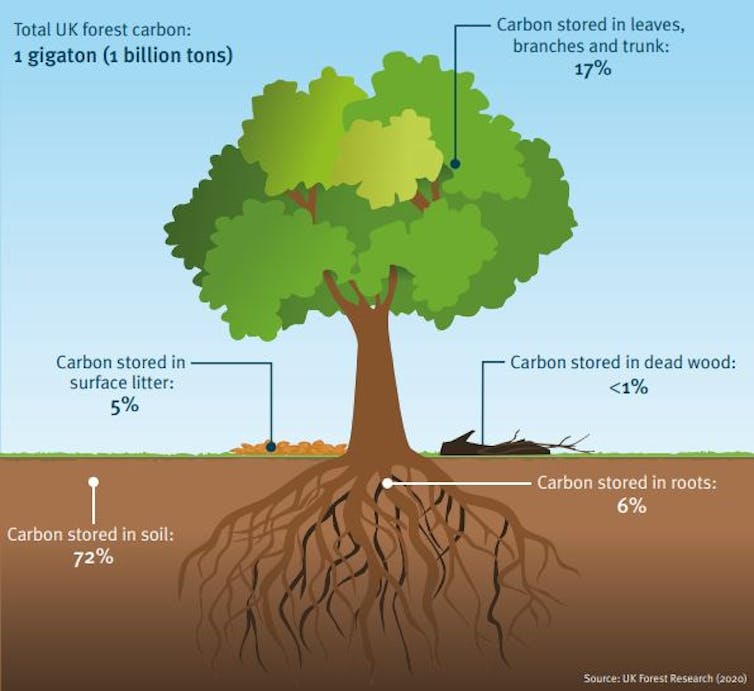
UK Forest Research, CC BY
If we ensure trees have enough water to drink, forests will grow tall and lush, creating shady canopies that starve smaller trees of light. If we increase the concentration of CO₂ in the air, plants will eagerly absorb it – until they can no longer extract enough fertiliser from the soil to meet their needs. Just like a baker making a cake, plants require CO₂, nitrogen and phosphorus in particular ratios, following a specific recipe for life.
In recognition of these fundamental constraints, scientists estimate that the earth’s land ecosystems can hold enough additional vegetation to absorb between 40 and 100 gigatonnes of carbon from the atmosphere. Once this additional growth is achieved (a process which will take a number of decades), there is no capacity for additional carbon storage on land.
But our society is currently pouring CO₂ into the atmosphere at a rate of ten gigatonnes of carbon a year. Natural processes will struggle to keep pace with the deluge of greenhouse gases generated by the global economy. For example, I calculated that a single passenger on a round trip flight from Melbourne to New York City will emit roughly twice as much carbon (1600 kg C) as is contained in an oak tree half a meter in diameter (750 kg C).
Peril and promise
Despite all these well recognised physical constraints on plant growth, there is a proliferating number of large scale efforts to increase vegetation cover to mitigate the climate emergency – a so called “nature-based” climate solution. The vast majority of these efforts focus on protecting or expanding forests, as trees contain many times more biomass than shrubs or grasses and therefore represent greater carbon capture potential.
Yet fundamental misunderstandings about carbon capture by land ecosystems can have devastating consequences, resulting in losses of biodiversity and an increase in CO₂ concentrations. This seems like a paradox – how can planting trees negatively impact the environment?
The answer lies in the subtle complexities of carbon capture in natural ecosystems. To avoid environmental damage, we must refrain from establishing forests where they naturally don’t belong, avoid “perverse incentives” to cut down existing forest in order to plant new trees, and consider how seedlings planted today might fare over the next several decades.
Before undertaking any expansion of forest habitat, we must ensure that trees are planted in the right place because not all ecosystems on land can or should support trees. Planting trees in ecosystems that are normally dominated by other types of vegetation often fails to result in long term carbon sequestration.
One particularly illustrative example comes from Scottish peatlands – vast swathes of land where the low-lying vegetation (mostly mosses and grasses) grows in constantly soggy, moist ground. Because decomposition is very slow in the acidic and waterlogged soils, dead plants accumulate over very long periods of time, creating peat. It’s not just the vegetation that is preserved: peat bogs also mummify so-called “bog bodies” – the nearly intact remains of men and women who died millennia ago. In fact, UK peatlands contain 20 times more carbon than found in the nation’s forests.
But in the late 20th century, some Scottish bogs were drained for tree planting. Drying the soils allowed tree seedlings to establish, but also caused the decay of the peat to speed up. Ecologist Nina Friggens and her colleagues at the University of Exeter estimated that the decomposition of drying peat released more carbon than the growing trees could absorb. Clearly, peatlands can best safeguard the climate when they are left to their own devices.
The same is true of grasslands and savannahs, where fires are a natural part of the landscape and often burn trees that are planted where they don’t belong. This principle also applies to Arctic tundras, where the native vegetation is covered by snow throughout the winter, reflecting light and heat back to space. Planting tall, dark-leaved trees in these areas can increase absorption of heat energy, and lead to local warming.
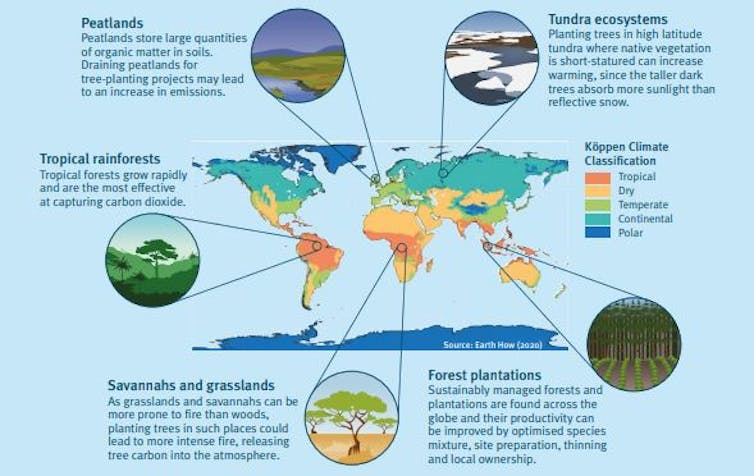
Stacey McCormack/Köppen climate classification, Author provided
But even planting trees in forest habitats can lead to negative environmental outcomes. From the perspective of both carbon sequestration and biodiversity, all forests are not equal – naturally established forests contain more species of plants and animals than plantation forests. They often hold more carbon, too. But policies aimed at promoting tree planting can unintentionally incentivise deforestation of well established natural habitats.
A recent high-profile example concerns the Mexican government’s Sembrando Vida programme, which provides direct payments to landowners for planting trees. The problem? Many rural landowners cut down well established older forest to plant seedlings. This decision, while quite sensible from an economic point of view, has resulted in the loss of tens of thousands of hectares of mature forest.
This example demonstrates the risks of a narrow focus on trees as carbon absorption machines. Many well meaning organisations seek to plant the trees which grow the fastest, as this theoretically means a higher rate of CO₂ “drawdown” from the atmosphere.
Yet from a climate perspective, what matters is not how quickly a tree can grow, but how much carbon it contains at maturity, and how long that carbon resides in the ecosystem. As a forest ages, it reaches what ecologists call a “steady state” – this is when the amount of carbon absorbed by the trees each year is perfectly balanced by the CO₂ released through the breathing of the plants themselves and the trillions of decomposer microbes underground.
This phenomenon has led to an erroneous perception that old forests are not useful for climate mitigation because they are no longer growing rapidly and sequestering additional CO₂. The misguided “solution” to the issue is to prioritise tree planting ahead of the conservation of already established forests. This is analogous to draining a bathtub so that the tap can be turned on full blast: the flow of water from the tap is greater than it was before – but the total capacity of the bath hasn’t changed. Mature forests are like bathtubs full of carbon. They are making an important contribution to the large, but finite, quantity of carbon that can be locked away on land, and there is little to be gained by disturbing them.
What about situations where fast growing forests are cut down every few decades and replanted, with the extracted wood used for other climate-fighting purposes? While harvested wood can be a very good carbon store if it ends up in long lived products (like houses or other buildings), surprisingly little timber is used in this way.
Similarly, burning wood as a source of biofuel may have a positive climate impact if this reduces total consumption of fossil fuels. But forests managed as biofuel plantations provide little in the way of protection for biodiversity and some research questions the benefits of biofuels for the climate in the first place.
Fertilise a whole forest
Scientific estimates of carbon capture in land ecosystems depend on how those systems respond to the mounting challenges they will face in the coming decades. All forests on Earth – even the most pristine – are vulnerable to warming, changes in rainfall, increasingly severe wildfires and pollutants that drift through the Earth’s atmospheric currents.
Some of these pollutants, however, contain lots of nitrogen (plant fertiliser) which could potentially give the global forest a growth boost. By producing massive quantities of agricultural chemicals and burning fossil fuels, humans have massively increased the amount of “reactive” nitrogen available for plant use. Some of this nitrogen is dissolved in rainwater and reaches the forest floor, where it can stimulate tree growth in some areas.
As a young researcher fresh out of graduate school, I wondered whether a type of under-studied ecosystem, known as seasonally dry tropical forest, might be particularly responsive to this effect. There was only one way to find out: I would need to fertilise a whole forest.
Working with my postdoctoral adviser, the ecologist Jennifer Powers, and expert botanist Daniel Pérez Avilez, I outlined an area of the forest about as big as two football fields and divided it into 16 plots, which were randomly assigned to different fertiliser treatments. For the next three years (2015-2017) the plots became among the most intensively studied forest fragments on Earth. We measured the growth of each individual tree trunk with specialised, hand-built instruments called dendrometers.
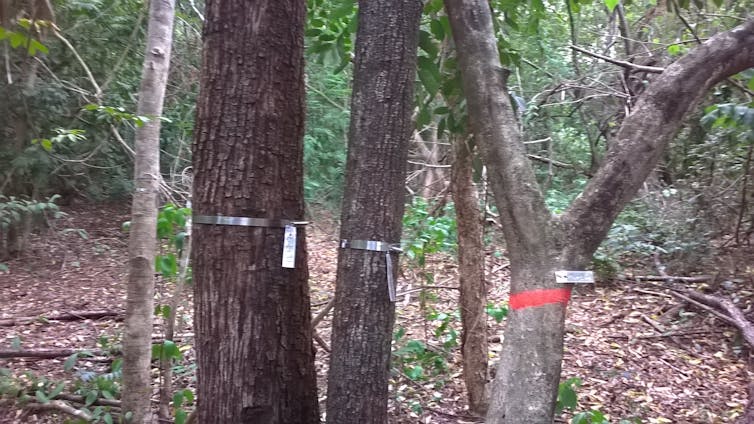
Author provided
We used baskets to catch the dead leaves that fell from the trees and installed mesh bags in the ground to track the growth of roots, which were painstakingly washed free of soil and weighed. The most challenging aspect of the experiment was the application of the fertilisers themselves, which took place three times a year. Wearing raincoats and goggles to protect our skin against the caustic chemicals, we hauled back-mounted sprayers into the dense forest, ensuring the chemicals were evenly applied to the forest floor while we sweated under our rubber coats.
Unfortunately, our gear didn’t provide any protection against angry wasps, whose nests were often concealed in overhanging branches. But, our efforts were worth it. After three years, we could calculate all the leaves, wood and roots produced in each plot and assess carbon captured over the study period. We found that most trees in the forest didn’t benefit from the fertilisers – instead, growth was strongly tied to the amount of rainfall in a given year.
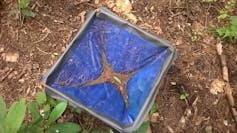
Author provided
This suggests that nitrogen pollution won’t boost tree growth in these forests as long as droughts continue to intensify. To make the same prediction for other forest types (wetter or drier, younger or older, warmer or cooler) such studies will need to be repeated, adding to the library of knowledge developed through similar experiments over the decades. Yet researchers are in a race against time. Experiments like this are slow, painstaking, sometimes backbreaking work and humans are changing the face of the planet faster than the scientific community can respond.
Humans need healthy forests
Supporting natural ecosystems is an important tool in the arsenal of strategies we will need to combat climate change. But land ecosystems will never be able to absorb the quantity of carbon released by fossil fuel burning. Rather than be lulled into false complacency by tree planting schemes, we need to cut off emissions at their source and search for additional strategies to remove the carbon that has already accumulated in the atmosphere.
Does this mean that current campaigns to protect and expand forest are a poor idea? Emphatically not. The protection and expansion of natural habitat, particularly forests, is absolutely vital to ensure the health of our planet. Forests in temperate and tropical zones contain eight out of every ten species on land, yet they are under increasing threat. Nearly half of our planet’s habitable land is devoted to agriculture, and forest clearing for cropland or pasture is continuing apace.
Meanwhile, the atmospheric mayhem caused by climate change is intensifying wildfires, worsening droughts and systematically heating the planet, posing an escalating threat to forests and the wildlife they support. What does that mean for our species? Again and again, researchers have demonstrated strong links between biodiversity and so-called “ecosystem services” – the multitude of benefits the natural world provides to humanity.
Carbon capture is just one ecosystem service in an incalculably long list. Biodiverse ecosystems provide a dizzying array of pharmaceutically active compounds that inspire the creation of new drugs. They provide food security in ways both direct (think of the millions of people whose main source of protein is wild fish) and indirect (for example, a large fraction of crops are pollinated by wild animals).
Natural ecosystems and the millions of species that inhabit them still inspire technological developments that revolutionise human society. For example, take the polymerase chain reaction (“PCR”) that allows crime labs to catch criminals and your local pharmacy to provide a COVID test. PCR is only possible because of a special protein synthesised by a humble bacteria that lives in hot springs.
As an ecologist, I worry that a simplistic perspective on the role of forests in climate mitigation will inadvertently lead to their decline. Many tree planting efforts focus on the number of saplings planted or their initial rate of growth – both of which are poor indicators of the forest’s ultimate carbon storage capacity and even poorer metric of biodiversity. More importantly, viewing natural ecosystems as “climate solutions” gives the misleading impression that forests can function like an infinitely absorbent mop to clean up the ever increasing flood of human caused CO₂ emissions.
Luckily, many big organisations dedicated to forest expansion are incorporating ecosystem health and biodiversity into their metrics of success. A little over a year ago, I visited an enormous reforestation experiment on the Yucatán Peninsula in Mexico, operated by Plant-for-the-Planet – one of the world’s largest tree planting organisations. After realising the challenges inherent in large scale ecosystem restoration, Plant-for-the-Planet has initiated a series of experiments to understand how different interventions early in a forest’s development might improve tree survival.
But that is not all. Led by Director of Science Leland Werden, researchers at the site will study how these same practices can jump-start the recovery of native biodiversity by providing the ideal environment for seeds to germinate and grow as the forest develops. These experiments will also help land managers decide when and where planting trees benefits the ecosystem and where forest regeneration can occur naturally.
Viewing forests as reservoirs for biodiversity, rather than simply storehouses of carbon, complicates decision making and may require shifts in policy. I am all too aware of these challenges. I have spent my entire adult life studying and thinking about the carbon cycle and I too sometimes can’t see the forest for the trees. One morning several years ago, I was sitting on the rainforest floor in Costa Rica measuring CO₂ emissions from the soil – a relatively time intensive and solitary process.
As I waited for the measurement to finish, I spotted a strawberry poison dart frog – a tiny, jewel-bright animal the size of my thumb – hopping up the trunk of a nearby tree. Intrigued, I watched her progress towards a small pool of water held in the leaves of a spiky plant, in which a few tadpoles idly swam. Once the frog reached this miniature aquarium, the tiny tadpoles (her children, as it turned out) vibrated excitedly, while their mother deposited unfertilised eggs for them to eat. As I later learned, frogs of this species (Oophaga pumilio) take very diligent care of their offspring and the mother’s long journey would be repeated every day until the tadpoles developed into frogs.
It occurred to me, as I packed up my equipment to return to the lab, that thousands of such small dramas were playing out around me in parallel. Forests are so much more than just carbon stores. They are the unknowably complex green webs that bind together the fates of millions of known species, with millions more still waiting to be discovered. To survive and thrive in a future of dramatic global change, we will have to respect that tangled web and our place in it.
target=”_blank” rel=”noopener”Bonnie Waring, Senior Lecturer, Grantham Institute – Climate Change and Environment, Imperial College London
This article is republished from The Conversation under a Creative Commons license. Read the original article.


Bonnie Waring deserves a Nobel Prize for her work. Most of what she wrote here is new to me — and, I’m sure, to most environmentalists. (The one thing I didn’t see mentioned is that young trees really don’t help with carbon capture at all. Depending on the species and its growth, trees are net carbon emitters for the first 20 years of more of their lives.)
That said, all of this should impress on us the gravity of the emergency we face, and the actions our so-called “leaders” aren’t taking. Among other things, we should be shutting down non-essential industries under a state of emergency — and by non-essential, I mean things like the auto industry, airlines, tourism, cattle, wine, etc., along with everything else that isn’t required for basic nutrition and sustaining life.
In addition, we should give the worst offending nations ultimatums (Brazil, China, Indonesia, and Australia come to mind), warning that unless they stop deforestation, coal use, palm oil production, etc., they will face international boycotts, and even more severe penalties. (The first snag in this plan, of course, is finding a major nation that is not itself a major offender.)
In 1942, the United States responded to the attack on Pearl Harbor with a declaration of war, a shutdown of the auto industry, and rationing of essential products. No great complaints resulted, because we were at war.
Today’s environmental emergency is infinitely greater. All that was at stake in the war with Japan was control of the Pacific. Tojo posed no threat to world forests, wasn’t poisoning the air to any measurable degree, and had no immediate desire or potential to cause a climate catastrophe or mass extinction.
Today, however, it appears we would rather die and take the planet down with us than threaten jobs or next year’s corporate earnings reports. As a species, I suppose we have the right to commit collective suicide. (The rest of the world, I’m sure, would be overjoyed.) But we have no right to exterminate another species — to say nothing of the dozens we drive to extinction every day.
Industrial humanity (a.k.a. capitalism, a.k.a. us) is the greatest criminal in history. We make Hitler, Tojo, Stalin, Mao, Idi Amin, and Pol Pot look like a boys choir. And our leaders have no answer but a new generation of environmental terrorists — “green energy” extraction rapists, 5G assassins, “green revolution” mass poisonings, etc.
Isn’t it about time we declare war on them?